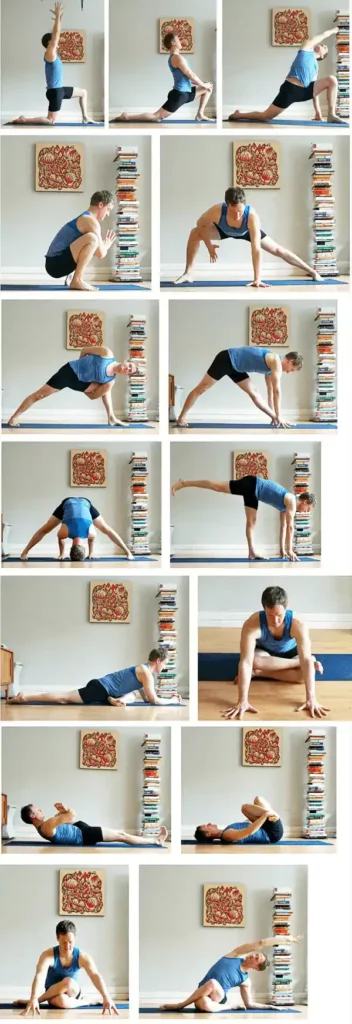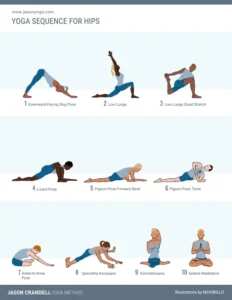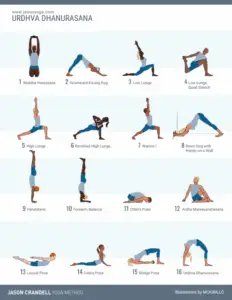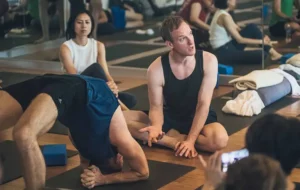
These are, hands down, my 15 favorite hip opening yoga poses.
Creating a balanced, effective hip-opening sequence is simple if you know how the hip muscles are laid out. When you don’t have for a map for their hips, you’re at a higher risk for overstretching your hamstrings and external rotators compared to your hip flexors and adductors. Teachers make this mistake in their sequencing regularly and, as a result, hamstring insertion injuries are one of the most prevalent injuries in modern yoga.
If you haven’t read them already, start with Yoga and Your Hips, Part I and Part II . The model of the “5 Muscular Compartments of Your Hips” in Parts I & II is the same approach that I take when I teach anatomy live and online. (And If you want to learn even more about yoga anatomy and yoga sequencing, you can join me in my managing yoga injuries course or yoga sequencing course.)
The sequence here contains my three of favorite postures for each compartment of your hip. I practice this sequence several times a week and I still love the feeling of space and mobility it gives me. I hope it helps you feel good in your body, too!
15 Hip Opening Yoga Poses
Hip Compartment #1: Hip Flexors
Pose 1: Anjaneyasana
Keep your back thigh vertical here. Why? Because keeping your back thigh vertical and stacking your pelvis and spine directly over your thigh helps stretch your quadriceps and hip flexors.
Pose 2: Anjaneyasana
Lower your hips forward and down to isolate and stretch your hip flexors, especially your rectus femoris.
Pose 3: Anjaneyasana
Leaning into the side bend from Anjaneyasana helps stretch your obliques and quadratus lumborum along with your hip flexors.
Hip Compartment #2: Adductors
Pose 1: Malasana
Malasana provides a thorough, inner leg stretch while also flexing the knees and hips deeply.
Pose 2: Prasarita Padottanasana with bent knee
Bending one knee and pressing your forearm against your thigh allows you to create a deep, sustained stretch on the entire adductor group.
Pose 3: Bound Side Angle
The action of binding in this posture provides you with a shoulder opener in addition to the adductor stretch.
Hip Compartment #3: Hamstrings
Pose 1: Parsvottanasana
This foundational standing pose allows you to focus on stretching one set of hamstrings at a time. This may be more effective for students with tight hamstrings than stretching both sets of hamstrings at time like you do in Uttanasana.
Pose 2: Prasarita Padottanasana
In addition to stretching your hamstrings, this pose also stretches your adductors.
Pose 3: Standing Split / Warrior III Hybrid
While similar to Parsvottanasana, this one-legged standing posture provides a deep, isolated hamstring stretch.
Hip Compartment #4: External Rotators
Pose 1: Pigeon Pose
This bittersweet posture uses the weight of your entire body to stretch your external rotators.
Pose 2: Ankle-to-Knee
Placing one ankle on the opposite inner knee externally rotates your thighs even more deeply than Pigeon Pose.
Pose 3: Reclined Pigeon
Clasping your leg and reclining in Pigeon Pose stretches your glutes, external rotators, and abductors.
Hip Compartment #5: Abductors
Pose 1: Reclined Gomukhasana
Reclining in Gomukhasana allows your entire body to relax and settle, while providing you with a deep abductor stretch.
Pose 2: Gomukhasana
This classic seated posture provides efficient leverage for opening your abductors.
Pose 3: Gomukhasana with sidebend
Including a sidebend in this posture gives you a deep abductor stretch while also releasing tension in your obliques and quadratus lumborum.



